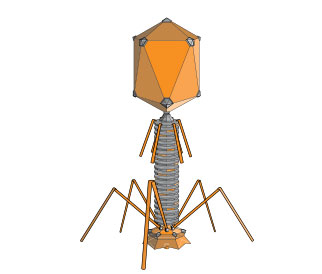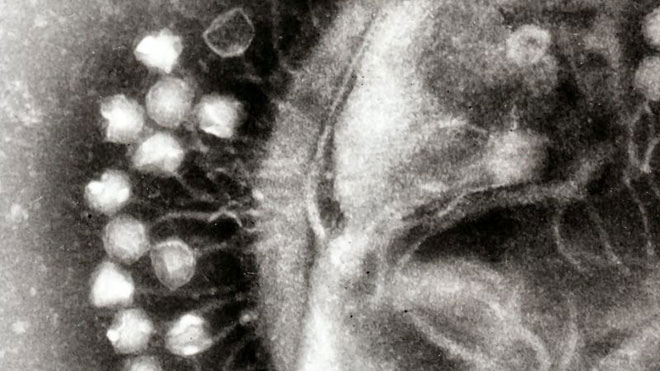Science has discovered giant viruses with the ability to 'steal' other species' characteristics
Finding and researching new viruses has always been a top priority for many cell scientists around the world. Recently, scientists discovered that a bacterium - a virus that "eats" bacteria - is bigger and more special, and it also has the ability to learn the "tricks" that only bacteria have.
These organisms are not only large in size, they also possess a huge number of pairs of genes. The newly discovered phage has hundreds of genes with millions of pairs, so big that it can be observed using regular microscopes.

The shape of a phage being constructed in 3D.
These giant viruses are often found in amoeba , and in environments far away from humans. However, researchers have also detected cases that occur in areas close to where we live. In a report collected last year, the viruses also exist in the gut bacteria of people in Bangladesh. At the same time, in a study published in the journal Nature, the team of scientists also showed evidence of its existence in various parts of the world.

These giant viruses are often found in amoeba.
Currently, scientists often study and discover new viruses by filtering DNA groups from test pieces collected in different environments. In this case, they examined samples collected from human and animal feces, large bodies of water both on land and in oceans, mudflats and hot springs. After removing the excess bacteria / viruses, they will reconstruct the phylogenetic genome from what is left.
" The pairs of genes we find are often very large, much larger than normal phages ," says the author of the study Jill Banfield, a professor of geoscience at the University of California Berkeley. , for or.
Banfield and her team claim to have found more than 300 types of phage bacteria with more than 200,000 pairs of genes - maybe even 735,000 pairs of genes, which is 10 times more than normal viruses. These giant phages carry the genes of other living things, allowing them to perform the amazing survival behaviors found in other species.
For example, many of these phages have important genes for the CRISPR system - used by bacteria to get rid of viruses. This is an immune system that works by dissecting the DNA of malignant viruses that want to attack them. According to researcher Basem Al-Shayeb, these genes may have been used by giant bacterial entities to enhance host resistance, as a form of " fighting other viruses to obtain." host ".

The CRISPR system will cut the DNA of dangerous viruses to bacterial entities.
Thanks to this discovery, we know we still need a lot of research in the field of viruses - the capabilities, shapes, and sizes need to be explored for scientific purposes. While these giant bacterial entities have much in common with other giant viruses, they are unrelated, in the same way that bacteria are not related to amoeba or eukaryotes.

The bacteria that live in the gut can control other bacteria to cause health problems.
Although the bacteria that live with amoeba are not a concern for humans, the bacteria that live in the gut can control other bacteria to cause many health problems; for example, resistance genes transfer from one species to another. Currently, bacteriophage research is limited, but such studies can improve the gene editing tools we have, the CRISPR gene editing system.
- Be wary of viruses against anti-virus software
- Detecting giant virus underneath the Indian city, copying the gene of the host
- Discovered a giant virus that 'eats alive' bacteria
- Detecting giant viruses raises the question of what is life?
- The newly discovered giant virus can change our definition of viruses
- Discovered a new giant oyster species living in Australia
- Virus detection makes people silly
- Giant crabs weigh up to 4kg
- Viruses exploiting bank account numbers appear
- Two new turmeric species were discovered in Vietnam
- Learn about the new giant red leech species found in Indonesia
- Pandoravirus - missing link found between virus and cell
 Why do potatoes have eyes?
Why do potatoes have eyes? 'Tragedy' the world's largest carnivorous life: Death becomes ... public toilet
'Tragedy' the world's largest carnivorous life: Death becomes ... public toilet Tomatoes were once considered 'poisonous' for 200 years
Tomatoes were once considered 'poisonous' for 200 years Detecting microscopic parasites on human face
Detecting microscopic parasites on human face